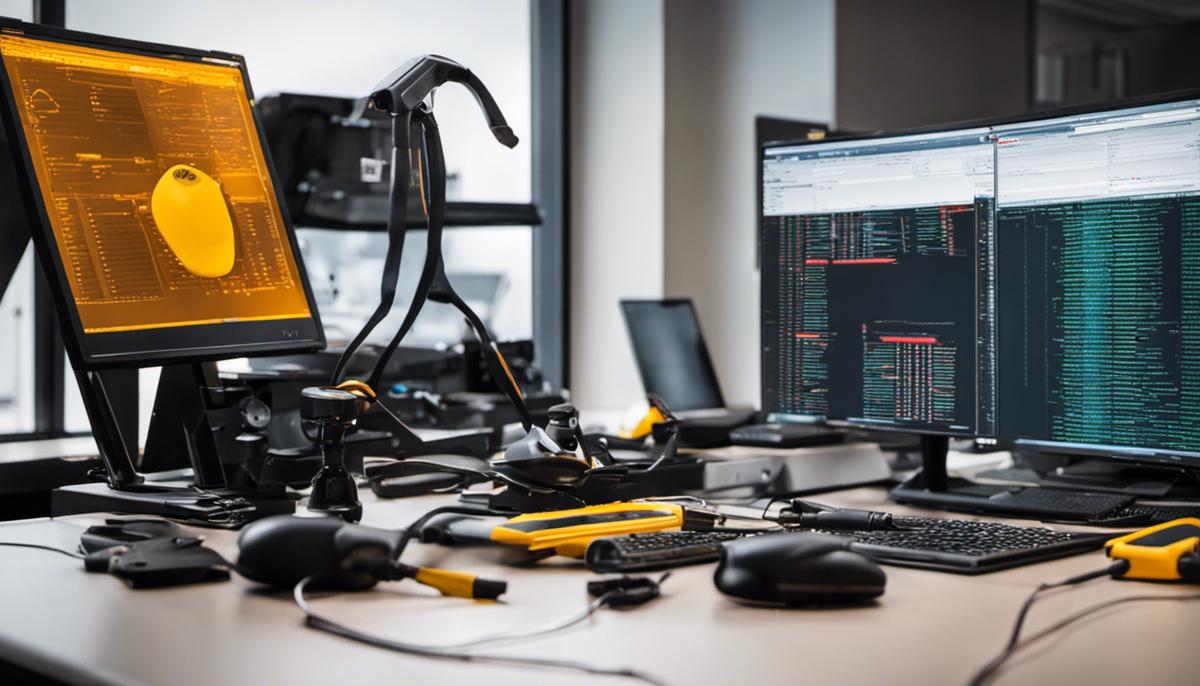One of the pivotal ways to ensure digital security is through the cyber security penetration tester, which requires in-depth understanding and expertise. This piece aims to introduce you to the critical aspects of penetration testing, beginning with a solid foundation on its importance, definition, and overall landscape. Furthermore, it will illuminate the role of a penetration tester alongside the key responsibilities and skillsets required for this significant role. Diving deeper, it aims to explore the commonly used techniques and the myriad tools available for the task. You will get to comprehend how these tools help in diagnosing and preventing potential threats.
Understanding Cyber Security Penetration Testing
TITLE: Unmasking the Cybersecurity Frontline: The Critical Role of Penetration Testers
In the fast-paced, technology-driven world of today, cybersecurity has become an inherently crucial component of our daily lives. Within the sprawling jungle of firewalls, encryptions, and secure servers, One role stands out – the Penetration Tester, or “pentester”. Often hailed as the white-hat hacker, a penetration tester serves as the first line of defense in the cybersecurity realm.
The primary function? To discover and probe vulnerabilities within an organization’s digital security system. Simulating a real-world attack, the penetration tester breaches the system, thereby revealing flaws for subsequent remediation. It’s a race against would-be malicious attackers – identify and patch vulnerabilities before they do.
Meticulous mimicking of typical hacks is a core skill. It necessitates a comprehensive understanding of various hacking strategies, exploitation techniques, and intrusion detection systems. In essence, pen-testers think and act like hackers – with one crucial distinction: they wield their skills to fortify systems, not compromise them.
Often, software is just as critical as the strategy. One thing’s for sure – there’s no room for half-measures. Therefore, the penetration tester’s kit must be stocked with potent tools such as Burp Suite, Nessus, Wireshark, and Metasploit, among others. Each tool serves a specific purpose and, when combined, creates an arsenal capable of testing every crevice of the digital fortress.
Beyond reconnaissance and intrusion, a penetration tester’s role doesn’t end. Valuable insights from the simulated ‘attacks’ warrant detailed reports for executives and technical staff. Penetration testers excel in decoding technobabble into understandable insights, pinpointing vulnerabilities, and suggesting appropriate countermeasures.
The fast-evolving landscape of cyber threats demands continual learning and agility. Therefore, a penetration tester must stay ‘in the know’ – from small security updates to major disruptive incidents. Multilayered domains like IoT, Cloud Security, or Machine Learning each pose unique threats and, hence, require specialist knowledge.
Working in cybersecurity also necessitates a strong ethical underpinning. Trust is integral. While entrusted with sensitive intellectual property, potential vulnerabilities, and intricate system designs, a penetration tester must uphold rigorous standards of professional ethics, integrity, and discretion.
To sum up, the role of a penetration tester blends technical wizardry, strategic ingenuity, and ethically driven tenacity. It’s about wearing the hacker’s hat yet championing cybersecurity, pushing the limits of technological defenses, and then fortifying them – a role that’s as necessary as it is intriguing. In an era where cyberattacks are not just common but potentially calamitous, penetration testers stand in the gap, shielding digital assets from unseen predators. What is the essence of their role? They aren’t just guardians. They’re digital knights.

Exploring Common Penetration Testing Techniques
Prevailing Penetration Testing Techniques in Today’s Cybersecurity Landscape
Penetration Testing, or Pen Testing as it is commonly referred to, is the linchpin in cybersecurity. As guardians against cyber threats, professionals in this field elevate our digital defenses through several testing techniques that adapt to the perpetually changing terrain of cyber threats. Not allowing for any redundancy, this article aims to elucidate distinct techniques used by penetration testers today.
Firstly, the ‘Black Box Testing’ technique reigns supreme. An approach that mimics real-life hackers, it leaves pen testers in the dark regarding the system’s configuration and internal structure, allowing them to devise unique solutions. Real-life scenarios optimize the testers’ cognitive agility and continually build up their intellectual armory.
Another common technique employed by these tech maestros is ‘White Box Testing’. It capitalizes on complete access to the code and network infrastructure of the system in question. With the advantage of viewing the internal workings, Pen testers can devise accurate and targeted attack methods. It’s like having schematics of the fort you’re planning to infiltrate – precise and extremely effective.
The ingenious ‘Gray Box Testing’ technique integrates the aforementioned techniques. With partial system access, pen testers innovatively use limited insight to conduct competent testing – a blend of both real-life scenarios and precision. As expected, this technique is quite prevalent due to its balanced blend of unknown and known variables.
The ‘Targeted Testing’ technique involves collaboration between the organization’s IT team and the pen testers. This cooperation is fuel for informed pen testing efforts, resulting in targeted strategies for maximizing the security wellness of the digital asset.
‘External Testing’ is no stranger in the pen testing realm. Here, testers mimic attacks on systems visible to the outside world, such as the company’s website or email servers. They diligently work to expose vulnerabilities that external cyber threats might exploit.
In contrast, ‘Internal Testing’ seeks to address what could happen if the defenses were breached. Functioning as an internal source, hackers are assumed to be inside the command center, and the technique works to figure out ways to beef up internal defenses.
Finally, the ‘Social Engineering’ technique brings the human element into testing. While technical aspects form the majority of testing components, social engineering focuses on potential human vulnerabilities. It seeks to identify the possibilities of manipulation through trickery or persuasion, a rather unconventional but necessary approach.
Technologies evolve at a pace faster than light, bringing with it cybersecurity threats that linger in the somber shadows of digital progress. As new malware, viruses, and hacking tactics develop, penetration testers are expected to morph and adapt to combat these threats. The prevalent techniques discussed here are not exhaustive. They’re steppingstones in the path of constant learning, innovation, and digital safeguarding.

Understanding Penetration Testing Tools
Diving further into the field of penetration testing, it’s crucial to identify a specific set of tools that are indispensable to any tester. Selecting the right resources is not just a part of the job but a purveyor of success or failure. An armory of potent tools isn’t just a boon but a necessity.
Rolling right into it, Metasploit Framework tops the list. Regarded as the ultimate Swiss Army knife for penetration testing, its flexibility and universality make it every tester’s first pick. Boasting a corpus of exploits, it also provides numerous post-exploitation options that can swing the balance decisively.
Next on deck, the Nmap (Network Mapper) slides into a critical role due to its multi-faceted brilliance. Acting as a network scanner, monitor, and security auditor, it’s an all-in-one tool that provides invaluable insight into networks and systems.
WireShark takes the crown when it comes to network protocol analyzers. Its ability to visualize data from networks, disambiguate, and dissect network packets makes it a valuable addition to any toolkit.
Burp Suite, on the other hand, is an incredible web application security testing toolkit. Its power lies in the ability to function as a proxy server between the client and the server, thereby scrutinizing the requests and responses.
Contributing to the open-source expanse, OWASP ZAP (Zed Attack Proxy) offers another incredible option for web app testing. Geared for both beginners and experienced testers, its automatic scanners and passive scanners pave the way for a comprehensive testing experience.
Speaking of automated testing, Nessus, with its proficiency in vulnerability scanning, is pivotal for efficient, comprehensive evaluation. By using plugins and scripts, Nessus adapts to the tester’s needs, delivering a bespoke and robust testing process. Similarly, Acunetix assists in automated web application security testing, reviewing HTML5, JavaScript, and even single-page applications, centering on SQL Injection and Cross-Site Scripting (XSS).
Moving a step ahead into wireless testing, Aircrack-ng is the prolifically used suite. With its functions ranging from packet capture attack detection to key cracking, it’s an irreplaceable tool in battling against wireless intrusions.
Lastly, taking into account the human side of security, Social-Engineer Toolkit (SET) makes a significant impact. It aids in designing trusted phishing attacks, thus highlighting any human-induced vulnerabilities.
In a nutshell, the inclusion of these tools in a penetration tester’s arsenal enables a comprehensive stance against cyber threats. However, merely possessing these tools isn’t enough. One must master them to unriddle the complexities encountered, delivering not just a client-at-peace but securing the digital perimeter extensively and exhaustively.

Stages of A Penetration Test
The Comprehensive Guide to Conducting a Penetration Test
The mechanics of conducting a penetration test can be intimidating to the uninitiated. However, adopting an ordered, systematic approach will simplify the process and enhance the user experience. To provide an overview, the process typically features the following phases:
- Planning: This is the initial step, where the scope and goals are defined. It signifies the road mapping where operational aspects of the testing are determined, boundaries are marked, requirements are recognized, and a set of rules are agreed upon. Key stakeholders will agree on the methods to be used, services to be tested, and what constitutes an acceptable test.
- Reconnaissance: Following planning, the reconnaissance phase focuses on gathering as much information about a system or network as possible before attacking it. Techniques applied here include passive information gathering (researching the target online), scanning (via tools like Nmap or Nessus), and network enumeration.
- Assessment: Proceeding toward the central component of the test, the vulnerability assessment involves identifying potential points of exploitation in a system’s security. With the aid of tools like Metasploit, OWASP ZAP, and WireShark, testers can thoroughly analyze the platform. Automated software can also be used during this phase to speed up the process and discover vulnerabilities that can be missed in a manual review.
- Exploitation: This is where the real action starts. The purpose of exploitation in pen testing is to demonstrate a confirmed vulnerability. Not merely pointing out a weak spot, testers actually exploit it. Known as the “proof-of-concept,” the exploit verifies real security weaknesses, illustrating the potential effects of a malicious attack.
- Post-Exploitation: In the post-exploitation phase, testers determine the value of the compromised system and maintain access for later use. The objective here is to identify the data that could be accessed in the event of a successful attack. This provides an in-depth understanding of what and how much damage could be inflicted.
- Reporting: After completing the test, a comprehensive report is prepared outlining the vulnerabilities found, data that was accessed, and the success of each attempt. This phase is critical, as it provides the organization with insights needed to understand its vulnerabilities and mitigate them effectively.
To maximize the efficiency of penetration testing, it’s imperative to go through all the phases in the order presented. Skipping or rushing a phase may cause vital aspects to be overlooked, leading to an imprecise representation of the system’s security.
Equally important is constant upskilling and knowledge improvement in this area. Penetration testing, like cybersecurity, is dynamic, and the methodologies, techniques, and tools used are evolving continually. A passion for continuous learning and up-to-date knowledge is crucial for every pen-tester.
The essence of penetration testing boils down to emulating possible attacks to find vulnerabilities and then taking steps to reinforce those areas before a malicious actor can exploit them. With the rising magnitude of cyber threats, penetration testers play an indispensable role in safeguarding an organization’s digital assets. Overall, it’s a fascinating discipline, fusing technical know-how with an attacker’s mindset and a knack for problem-solving.

Ethics and Legalities in Penetration Testing
Now, let’s dive into the guiding principles that provide an ethical and legal framework around the practice of penetration testing, an integral facet of today’s cybersecurity landscape.
One of the key guiding rules is obtaining legal permission. This cannot be emphasized enough. Before penetration testing commences, there should be explicit consent from the owner of the system being tested. Starting a test without authorization is not only unethical, it can be illegal. Thus, penetration testers must always ensure they have documented consent.
Respecting the privacy of the client is another pillar of ethical practice in penetration testing. Testers may accidentally stumble upon sensitive data during their analyses – it’s critical that this data is neither disclosed nor misused. Confidentiality must be upheld at all times to ensure the trustworthiness of the service provided.
Limiting testing to agreed boundaries is also a key principle that needs to be strictly adhered to. Straying outside of these boundaries is not only unprofessional, but it could also lead to legal ramifications. The scope of testing should be clearly defined and agreed upon before starting, which includes the extent and the methods to be used.
It’s important to remember that these tests can sometimes lead to the unintentional discovery of major vulnerabilities and risks. Penetration testers must adhere to responsible disclosure practices. This means promptly, confidentially, and directly informing the client of any significant discoveries providing them with the appropriate time and resources to address the issue before it’s made public (if it needs to be).
Last but certainly not least, integrity forms the foundation of ethical penetration testing. Testers need to maintain a professional demeanor to avoid conflicts of interest, deception, or any form of misleading behavior.
To ensure these standards are kept, many professional organizations, like The International Council of E-Commerce Consultants (EC-Council) and Offensive Security Certified Professional (OSCP), have strict codes of ethics that their certified professionals must follow. They also advocate the concept of ‘ethical hacking’, where the objective is to help protect systems rather than exploit them.
Looking to the future, it’s clear that penetration testing will continue to play a pivotal role in cybersecurity. As technology evolves, so too will the methods and techniques used by testers. However, one thing that will remain unchanged is the need for ethical and legal guidelines to ensure that the world of cybersecurity continues to maintain its credibility, reliability, and, most importantly, its effectiveness against the ever-present threat of cyberattacks.

Moving beyond the purely technical, this piece also ventures into the thorny terrain of ethical considerations and legal restrictions within penetration testing. This is of utmost importance in this field, as it’s crucial to obtain duly documented permissions, adhere to professional codes of conduct, and understand the legal implications of cyber security testing. Having traversed understanding penetration testing, common methodologies, the tools to use, the process, and now, ethics and legalities, it’s clear that the journey to becoming an adept cyber security penetration tester is comprehensive and challenging. However, with the right training, tools, and ethical approach, it will lead to a vital role in securing our evolving digital landscape.